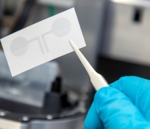 | | Electrodes for long-term monitoring of electrical impulses of heart or muscles were fabricated in the form of temporary tattoos produced using an ink-jet printer. An international research team involving Institute of Solid State Physics TU Graz together with IIT, Universitá degli Studi di Milano and Scuola Superiore Sant'Anna in Italy, presents this novel method in Advanced Science.
Paper in Advanced Science (open access)
In the presented method, conducting polymers are printed on commercial temporary tattoo paper, thus producing single or multiple electrode arrangements. The external connections necessary for transmitting the signals are integrated directly in the tattoo. The tattoo electrodes are then applied to the skin like temporary transfer tattoos and can hardly be felt by the wearer. Due to their extreme thinness (< 1 μm), the electrodes can be adapted perfectly to the uneven human skin, and can even be applied to parts of the body where traditional electrodes are not suitable, for instance the face. Francesco Greco explains: “With this method we have managed to take a big step forward in further developing epidermal electronics. We are on a direct road to making an extremely economical and simple as well as versatile applicable system which has enormous market potential.”
TU Graz News,
ORF.at in German,
KRONE.at in German,
derStandard.at in German,
PHYS.org,
Sciencedaily.com,
TV BROADCAST RAI3 TG Leonardo in Italian, COMPAMED-tradefair
|